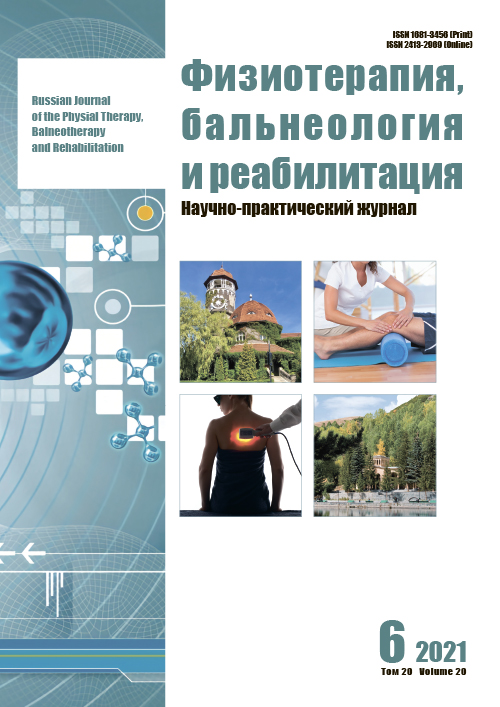Features of the formation of postoperative scars under the influence of rehabilitation programs in patients with chronic paraproctitis in the early postoperative period after minimally invasive surgical hospital-replacing technologies
- 作者: Kovalev S.А.1, Kotenko K.V.1
-
隶属关系:
- Russian Scientific Center of Surgery named after Academician B.V. Petrovsky
- 期: 卷 20, 编号 6 (2021)
- 页面: 503-510
- 栏目: Original studies
- ##submission.datePublished##: 15.09.2021
- URL: https://rjpbr.com/1681-3456/article/view/107985
- DOI: https://doi.org/10.17816/rjpbr107985
- ID: 107985
如何引用文章
详细
BACKGROUND: The study of the features of the formation of postoperative scars under the influence of rehabilitation programs in patients with chronic paraproctitis in the early postoperative period after minimally invasive surgical hospital-replacing technologies expands our understanding of the pathological condition and methods of its treatment.
AIM: To study the effect of various rehabilitation programs on the formation of postoperative scars in patients with chronic paraproctitis in the early postoperative period after minimally invasive surgical hospital-replacing technologies.
MATERIAL AND METHODS: The study summarized and analyzed the experience of surgical treatment of 180 patients with chronic paraproctitis using minimally invasive surgical hospital-replacing technologies and rehabilitation programs in the early postoperative period. Laser ablation of the fistula tract — the classic FiLaC technology was performed in 90 patients; modified FiLaC technology — 90. Each of the subgroups was divided into 3 groups: group 1 (main) included 30 patients who underwent a 4-component rehabilitation complex from the second day after the operation; group 2 (comparison) — 30 patients who underwent a 2-component rehabilitation complex from the second day after the operation and group 3 (control) — 30 patients, without an additional physiotherapeutic rehabilitation program. A comprehensive assessment of the features of the formation of postoperative scars was carried out as a criterion for the effectiveness of treatment, one of the tools of which was a complex transrectal ultrasound with color Doppler mapping, Dopplerography and sonoelastography at different stages of treatment.
RESULTS: All patients tolerated the course of treatment well: there were no cases of interruption of rehabilitation programs. The dynamic analysis of the data showed a statistically significant result: the best — in patients of the main group against the background of a 4-component rehabilitation program, the formation of postoperative scars accelerated, the formation of a mature scar occurred earlier, the risks of developing postoperative complications and relapses of the disease decreased.
CONCLUSION: The use of rehabilitation programs in patients with chronic paraproctitis in the early postoperative period after minimally invasive surgical hospital-replacing technologies can improve clinical results due to the complex physiotherapeutic effect. Complex transrectal ultrasound with color Doppler mapping, Dopplerography and sonoelastography in patients with chronic paraproctitis is an effective non-invasive diagnostic method: monitoring the formation of a postoperative scar and assessing the ongoing treatment.
全文:
作者简介
Sergey Kovalev
Russian Scientific Center of Surgery named after Academician B.V. Petrovsky
编辑信件的主要联系方式.
Email: kovalev_sa@rostgmul.ru
ORCID iD: 0000-0001-7697-3384
SPIN 代码: 6268-9694
MD, Cand. Sci. (Med.), Associate Professor
俄罗斯联邦, MoscowKonstantin Kotenko
Russian Scientific Center of Surgery named after Academician B.V. Petrovsky
Email: noc@med.ru
ORCID iD: 0000-0002-6147-5574
SPIN 代码: 5993-3323
Scopus 作者 ID: 23976052700
MD, Dr. Sci. (Med.), Professor, Corresponding Member of RAS
俄罗斯联邦, Moscow参考
- Kostarev IV, Matinyan AV, Titov AYu, et al. Preliminary results of treatment of patients with trans- and extrasphincteric fistulas of the rectum using laser thermal obliteration of the fistula tract. Surgeon. 2020;(3–4):34–42. (In Russ). doi: 10.33920/med-15-2002-04
- Shelygin YuA, Biryukov OM, Blagodarnyy LA. Clinical guidelines for the diagnosis and treatment of adult patients with chronic paraproctitis (fistula of the anus, fistula of the rectum). Moscow: Meditsina; 2013. 20 p. (In Russ).
- Khitaryan AG, Alibekov AZ, Kovalev SA, et al. Multistage minimally invasive treatment for perianal abscess. Koloproktologia. 2020;19(2):83–90. (In Russ). doi: 10.33878/2073-7556-2020-19-2-83-90
- Khitaryan AG, Alibekov AZ, Kovalev SA, et al. FiLaC technology for extrasphincteric fistulas. Koloproktologia. 2019;18(2):75–81. (In Russ). doi: 10.33878/2073-7556-2019-18-2-75-81
- Arroyo A, Pérez-Legaz J, Moya P, et al. Fistulotomy and sphincter reconstruction in the treatment of complex fistula-in-ano: long-term clinical and manometric results. Ann Surg. 2012;255(5):935–939. doi: 10.1097/SLA.0b013e31824e9112
- Wilhelm A, Fiebig A, Krawczak M. Five years of experience with the FiLaC™ laser for fistula-in-ano management: long-term follow-up from a single institution. Tech Coloproctol. 2017;21(4):269–276. doi: 10.1007/s10151-017-1599-7
- Giamundo P, Esercizio L, Geraci M, et al. Fistula-tract Laser Closure (FiLaC™): long-term results and new operative strategies. Tech Coloproctol. 2015;19(8):449–453. doi: 10.1007/s10151-015-1282-9
- Aleksandrov VV, Demyanenko SA, Mizin VI. Fundamentals of restorative medicine and physiotherapy. 2nd ed. Moscow: GEOTAR-Media; 2018. 208 p. (In Russ).
- Vladimirov AA, Ezhov VV, Ponomarenko GN. Physiotherapy. Kyiv: Format; 2013. 384 p. (In Russ).
- Epifanov AV, Achkasov EE, Epifanov VA. Medical rehabilitation. Moscow: GEOTAR-Media; 2015. 672 p. (In Russ).
- Ponomarenko GN. Medical rehabilitation. Moscow: GEOTAR-Media; 2014. 360 p. (In Russ).
- Mikhailova AA, Kotenko KV, Korchazhkina NB, Bedzhanyan AL. Database on the use of modern laser and non-drug technologies in the treatment of diseases of the rectum. Certificate of state registration of the database No. 20211622552, application No. 202162333, date of receipt 2021 Oct 27, state registration date 2021 Nov 18. (In Russ).
- Bogoslavsky VE, Korchazhkina NB, Kotenko KV. SOVA Decision Support System — SOVA DSS. Certificate of state registration of computer programs No. 3031665750, application No. 2021664810, date of receipt 2021 Sept 22, date of state registration 2021 Nov 1. (In Russ).
- Mikhailova AA, Kotenko KV, Korchazhkina NB, et al. Database of scientific research on the use of physical factors in surgery. Certificate of state registration of the database No. 20211621978, application No. 2021621880, date of receipt 2021 Sept 9, state registration date 2021 Sept 16. (In Russ).
- Ponomarenko GN, editor. Physical and rehabilitation medicine: national guidelines. Moscow: GEOTAR-Media; 2020. 688 p. (In Russ).
- Epifanov VA, Korchazhkina NB, Epifanov AV. Medico-social rehabilitation of patients with various pathologies: in 2 vols. Yablonsky SV, editor. Vol. 2. Moscow: GEOTAR-Media; 2019. 560 p. (In Russ).
补充文件






